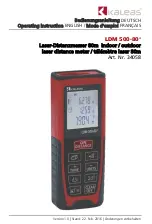
DOC-0171 Rev G-9
1 0
© 2017 DROPLET MEASUREMENT TECHNOLOGIES
2.0
Theory of Operation
The Single Particle Soot Photometer (SP2) utilizes the high optical power available
intra-
cavity from
an Nd:YAG laser. Light-absorbing particles, mainly black or elemental carbon in atmospheric
measurements, absorb energy and are heated to the point of incandescence. The energy emitted in
this incandescence is measured, and a quantitative determination of the black carbon mass of the
particle is made.
This mass measurement is independent of the particle mixing state, and hence
the SP2 is a reliable measure of the black carbon mass concentration. Since the SP2 detects single
particles, the SP2 can also measure the black carbon number concentration.
All particles scatter light, regardless of whether or not they absorb light. A scattering detector is
included in the SP2, which detects single particle scattering at 1064 nm, and the scattering signal
can be used to indicate the black carbon mixing state at the single-particle level. The scattering
detector can also be used to detect non-BC-containing aerosol number and mass concentrations.
The SP2 measures the light scattering and/or incandescence of each particle. The full scattering
and/or incandescence response of each particle is completely digitized for detailed analysis.
Figure 1: Front View of the SP2 Analyzer
1
Basic details on the theory of this technique are given by Stephens et al. (2003). Details on the
SP2 and application to atmospheric measurements are given by Schwarz et al. (2006).
Additional work on the theory of the measurements has been published by Moteki and Kondo
(2006).











































